Canada News
Oilsands could eventually acidify area size of Germany: study

File Photo: The largest and most precise study yet done on acid emissions from Alberta’s oilsands suggests they could eventually damage an area almost the size of Germany. (Photo by kris krüg/Flickr, CC BY-NC-ND 2.0)
The largest and most precise study yet done on acid emissions from Alberta’s oilsands suggests they could eventually damage an area almost the size of Germany.
The study finds that in 2013 more than 330,000 square kilometres in northern Alberta and Saskatchewan absorbed acid deposits high enough to eventually damage life in rivers and lakes.
“This work is a warning,” said Paul Makar, an Environment Canada scientist and lead author on the paper published in the Journal of Atmospheric Chemistry and Physics.
“If emissions continue at 2013 levels, there will be ecosystem damage over a very large area.”
Some industry players have invested heavily in recent years to reduce sulphur and nitrogen emissions, which lead to the acidification of water and soil. But it’s not clear whether overall oilsands emissions have fallen.
The research involved scientists at Environment Canada as well as their counterparts in Alberta and Saskatchewan and from Trent University in Peterborough, Ont.
Their work began with a study of 90,000 lakes to determine how different water bodies responded to acids and at what point they would no longer be able to buffer them. That data was used to create a map of carrying capacities across a large swath of the northern prairie provinces.
Previous studies used grids of 45 square kilometres. This one resolves to 2.5 square kilometres.
The team used the latest datasets and techniques — including satellite imagery — to model how 2013 emissions were likely to affect forests, rivers and lakes. Predictions were checked against measurements in the field and the model was then refined.
“If those emissions levels continue, there will be ecosystem damage for aquatic ecosystems over an area that’s about the size of Germany,” Makar said.
The study says tree growth would be stunted. Water plants would suffer from increased toxins. Fish and the bugs they prey on would get sick and reproduce less easily.
Although previous studies have suggested dust from plant operations would provide a buffer, Makar said that effect falls off well before the acidification does.
The study also shows some ecosystems are much more sensitive than others. A nearby lake could remain relatively healthy if it could buffer lots of acid, but the research suggests sensitive lakes could be affected as far east as Manitoba.
“There’s quite a far-reaching effect hundreds of kilometres downwind for ecosystems that are sensitive,” Makar said.
The paper’s conclusions rest on 2013 measurements. Both Syncrude and Suncor say they’ve substantially reduced their sulphur dioxide emissions since then.
Makar said scientists are working to confirm the numbers against other measurements from planes and satellites.
The paper can’t estimate the rate of acidification, he said.
“This ecosystem is being pushed past its buffering capacity and it will eventually go. I don’t have the when.”
The study builds on years of research on acid-causing emissions from the oilsands.
In 2009, Saskatchewan found rainfall in the La Loche area just across from Fort McMurray showed an average pH level of 4.93 — about three times as acidic as unpolluted rainfall and about the same acidity as a cup of black coffee.
A 2008 review found that up to 12 per cent of Alberta’s forest soils had probably reached the limit of how much acid they could hold, probably because of the oilsands. In 2006, the same researchers concluded that about two per cent of forest soils in Saskatchewan downwind from Alberta were over their limit.





















